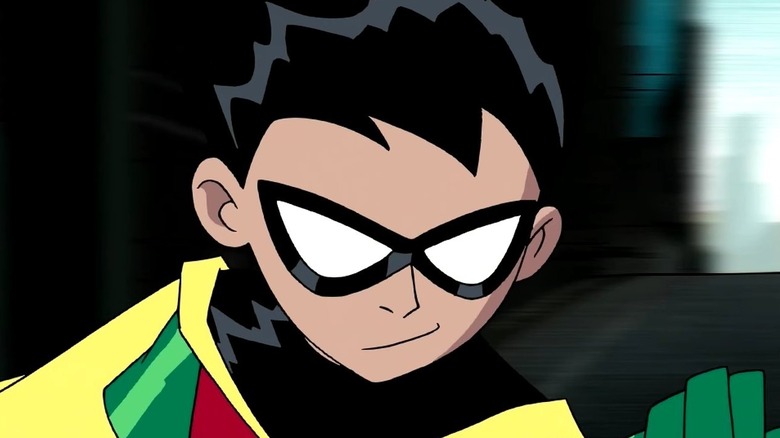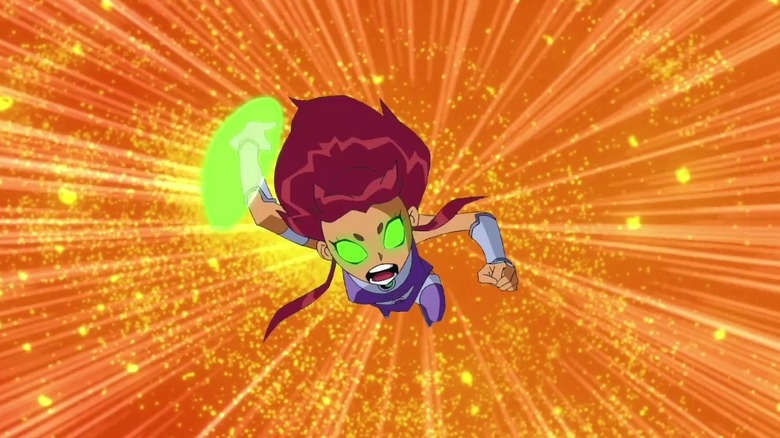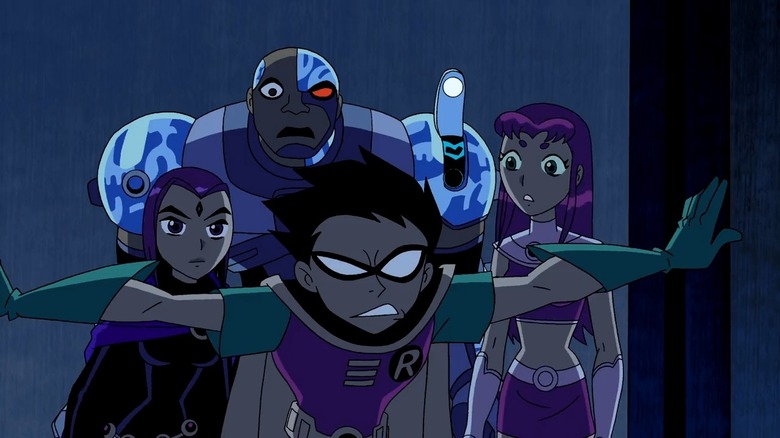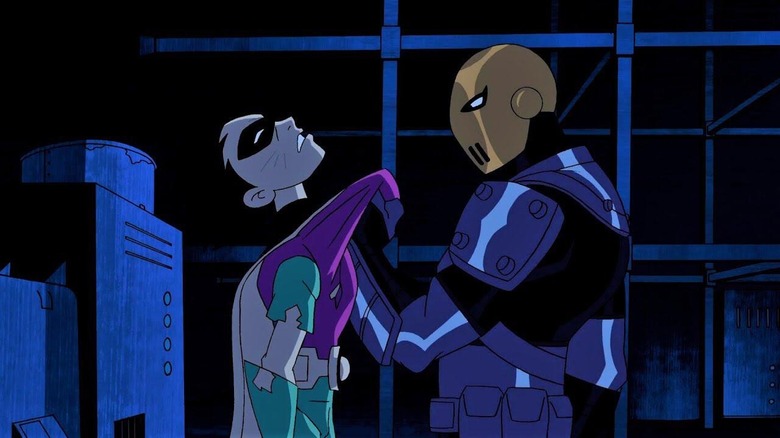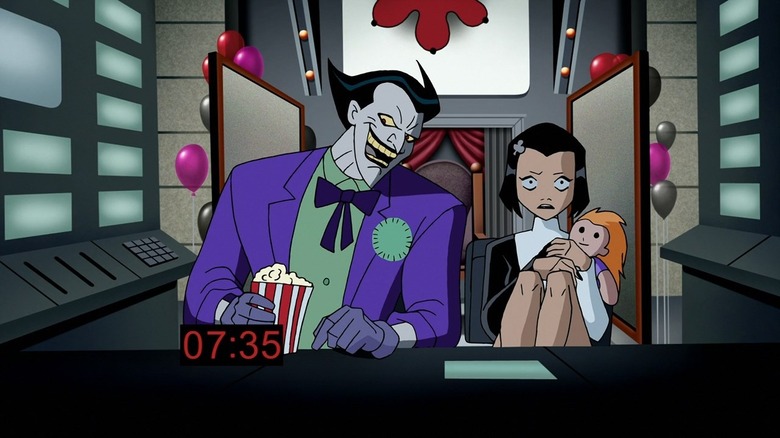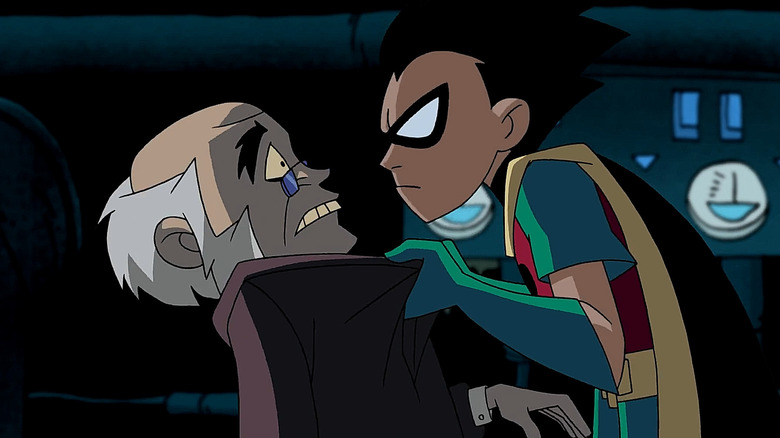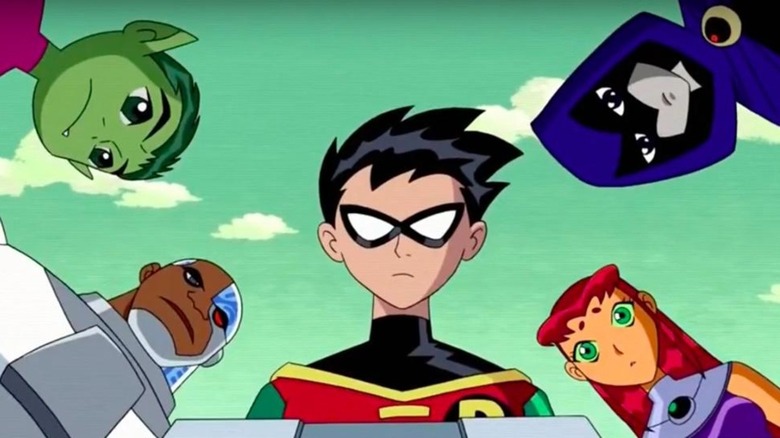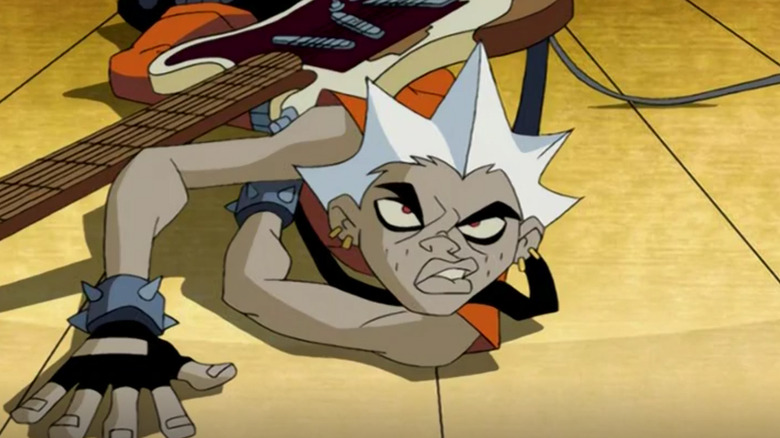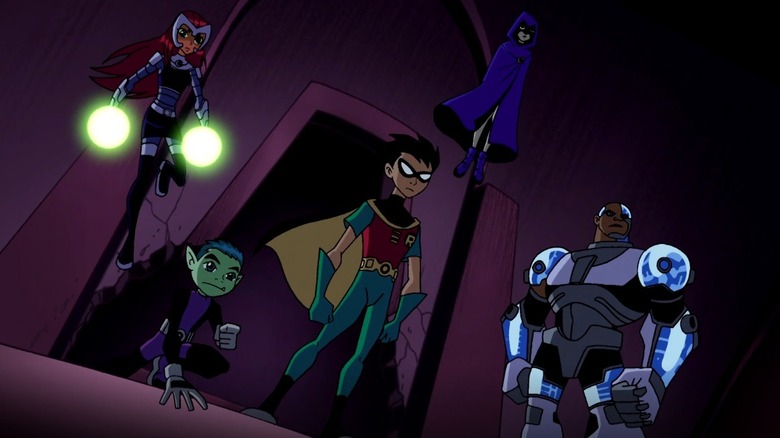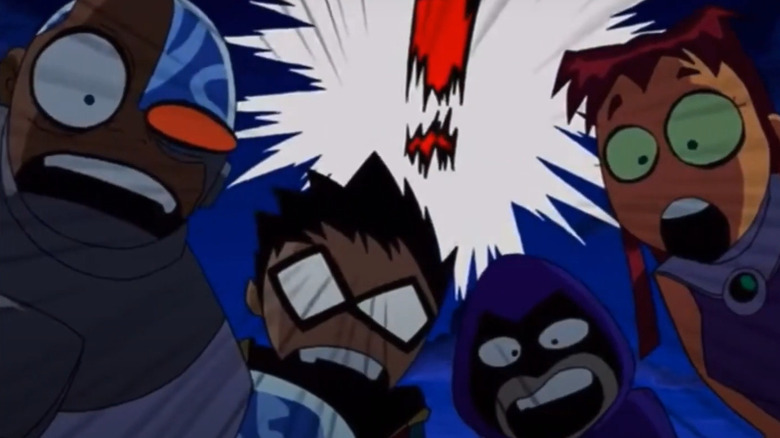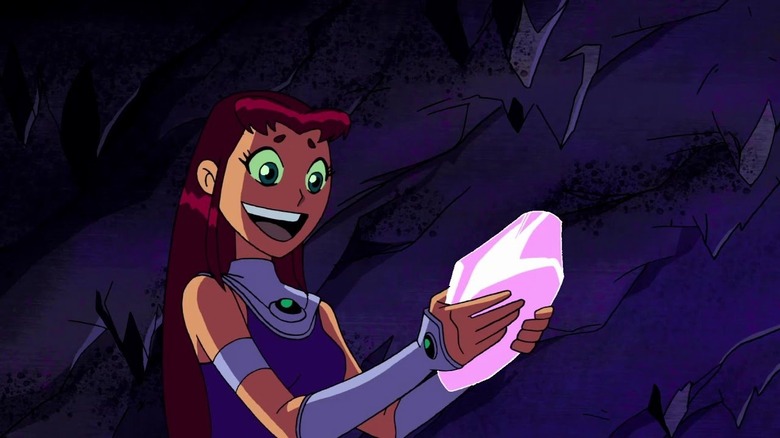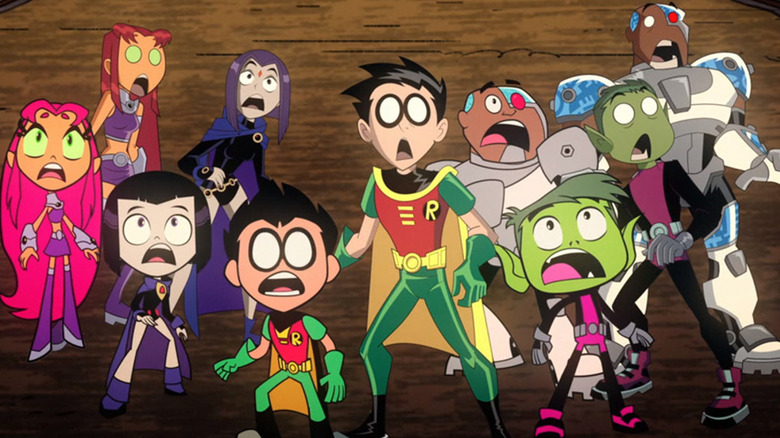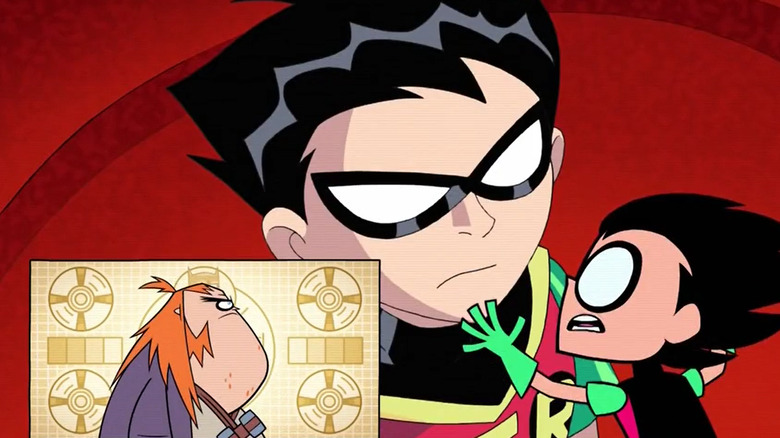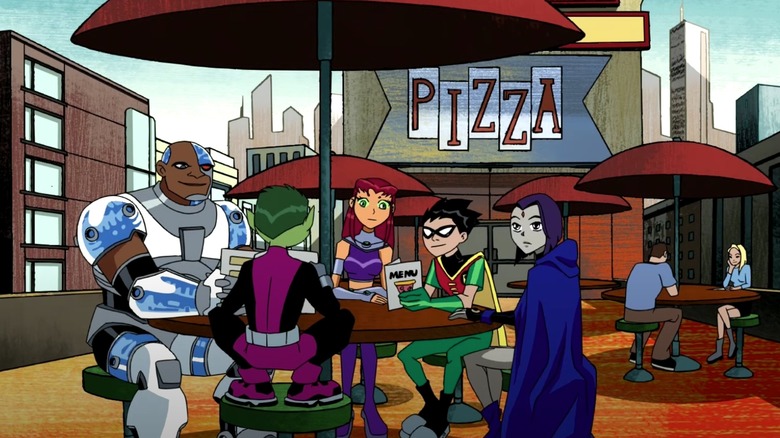Teen Titans: What Only True Fans Know About The Superhero Series
The Teen Titans might not be as famous as the Justice League, but they've still got plenty of devoted fans. The adolescent super-team has a distinguished history in the pages of DC Comics, reaching all the way back to the Silver Age. In 2003, they made the jump to the small screen with the release of the "Teen Titans" animated series. This beloved cartoon sees Robin, Starfire, Cyborg, Raven, and Beast Boy protect Jump City from nitpicky nerds with magical remote controls, villainous masterminds with robot armies, and interdimensional demons who kickstart the apocalypse.
This high-energy series is fondly regarded as one of the best cartoons of the 2000s, thanks to its distinctive animation, thoughtful storylines, and inventive use of the DC Comics canon. Perhaps you were a fan when you were a kid, or maybe you've come to the cartoon more recently. Either way, we're here to reveal all the details, references, and secrets only true fans know about "Teen Titans."
Two theme songs
"Teen Titans" skillfully juggles both serious and comedic moments. Many episodes skew heavily towards one of these tones, which is how you get very serious half-hours like "Haunted" and incredibly goofy installments like "Fractured." Interestingly, many of these episodes let audiences know which tone to expect through the theme song.
"Teen Titans" has two distinct theme songs, which share the same melody. One features English lyrics, while the other is in Japanese. This is a fun tip of the hat to the series' anime influence, but it's also an intriguing clue. Generally speaking, the show's most light-hearted episodes feature the Japanese theme song. The English version is used far more often, which means it isn't as obvious a tonal marker. But notably, all of the series' most serious-minded episodes feature the English theme song. When you learn that the Japanese version's nearly nonsensical lyrics refer to upholding traffic laws and eating whatever you want, this makes a certain amount of sense.
The original animated Titans
"Teen Titans" put its main characters — sans Robin — on the map, as far as mainstream pop culture goes. Sure, the group was known to comic book aficionados prior to 2003. But most people had never heard of the team, let alone individual members like Starfire and Beast Boy. However, this was not actually the first time the group had shown up in animation.
The Teen Titans first burst into being in 1964's "The Brave and the Bold" #54. They were such a hit that they made their cartoon debut only a few years later in the 1967 Filmation series "The Superman/Aquaman Hour of Adventure." This incarnation of the superhero team consists of Aqualad, Wonder Girl, Kid Flash, and Speedy. It's a far cry from the 2003 cartoon, which borrows far more heavily from the 1980s "New Teen Titans" comic series than the original Silver Age crew. But this inaugural animated outing is still a lot of fun.
Reimagining Slade
Season 1 of "Teen Titans" showcases Slade, the series' main villain. Little by little, the Titans become aware of this criminal mastermind. A brilliant strategist and expert fighter, Slade seeks to turn Robin into his apprentice through a series of trials by fire.
DC Comics fans know Slade by his full name, Slade Wilson, and his considerably more hardcore moniker, Deathstroke the Terminator. Deathstroke is a fiendishly effective mercenary, who's become one of DC's greatest villains in the years since his 1980 debut. While it's obvious who Slade in "Teen Titans" is supposed to be, you'll never hear him referred to as Deathstroke, nor does he commit the kind of brutal violence his comic counterpart pulls off. But the animated Slade has more in common with Deathstroke than you might think. Both characters turn Terra against the Titans, employ a mysterious manservant (seen in Season 1's "Divide and Conquer"), and have a daughter named Rose (though she's only featured in the tie-in comic).
The Teen Titans join the Royal Flush Gang
The 1990s and 2000s were a grand time for DC Comics fans with a taste for cartoons. The DC Animated Universe grew to include such classics as "Batman: The Animated Series," "Batman Beyond," and "Justice League Unlimited." Then came "Teen Titans." The show puts a lot of work into establishing itself as its own thing, separate from the larger DCAU. There are no crossover episodes with other DCAU properties, or even many nods to the wider DC universe (especially early on). But "Teen Titans" still manages to find a way into the wider DCAU.
In the "Justice League" episodes "Wild Cards" and "Wild Cards: Part II," the Joker makes use of the villainous Royal Flush Gang. In this particular incarnation, the five members of the team are voiced by the actors who play the five main Titans: Scott Menville (Robin), Greg Cipes (Beast Boy), Tara Strong (Raven), Khary Payton (Cyborg), and Hynden Walch (Starfire). Though none of the actors use the specific voice they employ on "Teen Titans," the sharp-eared viewer can detect the superheroes within the supervillains.
A fresh take on Robin
Few characters in the history of DC Comics have seen as much growth as Robin. The 2003 "Teen Titans" series played a major part in that. Historically, the general public has mostly known Robin as Batman's sidekick, an image fostered by the 1960s "Batman" show, the 1997 "Batman & Robin" film, and "Batman: The Animated Series." But "Teen Titans" showcases a new side of the old character. The Boy Wonder doesn't wear short pants and run after Batman on this cartoon. Here, Robin is serious, skilled, and just plain cool. Most importantly, he's a leader, rather than a sidekick.
This was a deliberate choice on the part of "Teen Titans" co-creator Glen Murakami. "We definitely wanted to show the audience a different Robin than they thought they were going to see, rather than someone who's normally a sidekick character," Murakami told Animation World Network. "Its like taking Batman and putting him out of your mind: How would you portray Robin? We made him confident and really kind of cool." Murakami went on to explain that Robin brings balance to the team, as a human who lacks superpowers. As fans of the show can attest, this only makes him more awesome.
Sharing the spotlight
Many super-team stories focus on one character more than others. Consider how much time X-Men media spends spotlighting Wolverine, for example. Not so on "Teen Titans." Here, each main character gets to be in the spotlight. In fact, every season focuses on one specific Titan.
Season 1 emphasizes Robin's personal journey as Slade attempts to lure him to his side. Season 2 introduces Terra, a drifter who ends up betraying the team, then earning her redemption. Season 3 sees Cyborg take center stage as he takes on Brother Blood and learns his own bionic limits. Season 4 makes things personal for Raven when her demonic father Trigon lays waste to the Earth. Season 5 sees Beast Boy lead a far-ranging storyline involving the Brotherhood of Evil. Sadly, Starfire doesn't get a season-long story arc of her own, though many individual episodes do focus on her. What results is a team show that's truly about the entire team.
The lost episode
You might have seen every TV episode of "Teen Titans," but that doesn't actually mean you've seen the entire series. There exists a secret slice of the "Teen Titans" story, created as part of a '00s promotional campaign. This installment is dubbed, appropriately enough, "The Lost Episode." The roughly 10 minute feature made its debut on the Postopia website, and was later included on the "Teen Titans: Trouble in Tokyo" DVD. Here, the Titans face off against a new enemy called Punk Rocket, who has an electric guitar capable of wreaking havoc on the city.
"The Lost Episode" is easy for fans to miss, given its unique distribution. But it's well worth seeking out, as it features some of the most gorgeously fluid animation in the entire series. Plus, it's fun to see Beast Boy take the bad guy down, thanks to his terrible taste in music.
Changing the characters
Adaptations of existing works are almost never one-to-one copies of their source material. This is especially true for a show like "Teen Titans," which draws from some pretty adult comics. A lot of characterization and backstory gets remixed for the purposes of the cartoon — but not always how you might expect.
Robin is almost completely divorced from Batman, save for a couple of indirect references. Starfire is a bit more naïve than her comics counterpart, and more fully clothed. Beast Boy's immaturity is dialed up. Cyborg is made a more light-hearted character. Raven is significantly more sarcastic than the Raven of the comics, whose dominant trait is mystical vagueness.
But as the show goes on, it becomes more comfortable with bringing in comics canon. Season 5's "Go!" is the most prominent example: This origin episode references all of the characters' comic roots, from Robin's time with Batman to the car accident that made Cyborg into a bionic being. That same season also spotlights the Doom Patrol, Beast Boy's original team. Taken as a whole, "Teen Titans" is a fascinating jumble of cartoon-specific details, references to the '80s "New Teen Titans" comics, and even a few nods to the team's Silver Age roots (Ding Dong Daddy, anyone?).
Getting super deformed
When "Teen Titans" first premiered in 2003, many viewers were immediately able to tell that the series is different from other DCAU shows. Its overtly comedic moments are a big part of why, as is the visual influence it draws from Japanese anime.
These two details overlap in a unique way, interestingly enough. "We're doing something that I think anime fans are familiar with; its called Super D," Glen Murakami told Animation World Network. "It's the equivalent of, say, a Tex Avery take ... I guess it gets kind of surreal, but it seems it's an effective way of telling the story, of conveying emotion in a really stylistic way."
Super D, or "super deformed" animation, has long been an anime staple. When conveying extreme emotion, characters become visually exaggerated, generally for comedic effect. This technique is often used during light-hearted moments on "Teen Titans": Eyes and mouths grow huge, noses disappear, and tall characters become tiny. It's a vivid way of expressing intensity, it separates comedic scenes from more tense moments, and it gives "Teen Titans" an entirely unique aesthetic.
Gasping is the key to Starfire
As an alien princess with a naïve outlook on Earth, Starfire gets some of the funniest and most emotional moments of "Teen Titans." Celebrated voice actor Hynden Walch brings these moments to dazzling life. Intriguingly, Starfire's ability to fly made a particularly huge impact on Walch's performance. "I knew she could fly ... something just clicked in my head about air," Walch explained to Toon Zone News. "So that's where all the gasping came from. That wasn't really in the script originally, but I heard from the network, 'They love the way you gasp' ... and so everything with Starfire is air air air. Breathing and air and everything is air, and total connection with your heart."
It's easy to overlook Starfire's airy voice and frequent gasps, but once you notice them, you can't stop. Furthermore, Starfire's breathiness differentiates her from Blackfire, her sinister sister, who is also voiced by Walch. "It was really fun to contrast that ... going from sweet Starfire to bad Blackfire," Walch remarked. "Just back and forth."
The reboot pays respect to the original
After five exciting seasons, "Teen Titans" came to an end in 2006. But in 2013, a new cartoon emerged: "Teen Titans Go!" You might think fans were excited, but in fact, many were confused. While "Teen Titans" has plenty of comedic moments, "Teen Titans Go!" is a full-on comedy, where the main characters act like goofy caricatures of their 2003 incarnations. Storylines are more focused on personal shenanigans than saving the world or being heroic, and absurdity rules the day.
Irritated op-eds popped up on websites like Inverse, unfavorably comparing "Teen Titans Go!" to the original "Teen Titans." But in fact, "Teen Titans Go!" has as much love for its predecessor as the crankiest fans do. It makes this resoundingly clear in the 2019 crossover film "Teen Titans Go! vs. Teen Titans." In this cartoon caper, the 2003 Titans meet the 2013 Titans through multiversal shenanigans. They immediately clash; 2013 Robin even develops a bit of a complex over how much cooler 2003 Robin is. But in the end, they learn to work together, despite their many differences.
An in-canon explanation for the reboot
Continuity is at the heart of superhero stories. Creators must reference many years of fictional events when they set out to tell a new tale, making sure nothing they introduce conflicts with anything already in canon. If things grow too complicated, they can wipe the slate clean with a reboot. But even this approach is complex, as "Teen Titans Go!" amply proves.
In Season 3's "The Fourth Wall," supervillain Control Freak informs the Titans that he created them and the show they star in by rebooting the 2003 "Teen Titans" cartoon. Using his magical remote, he dazzles the 2013 Titans with clips of their ultra-cool 2003 selves. Now he regrets his decision, deeming "Teen Titans Go!" a dumbed-down mistake, and plans to reboot the characters and their world once again in the hopes of making something high-brow. Thus, "The Fourth Wall" cements the continuity between "Teen Titans" and "Teen Titans Go!" in the most absurd way possible.
Am amazing work environment
Today "Teen Titans" is fondly remembered as one of the best superhero cartoons ever made. But even though it features all of the usual tropes — exotic villains, world-threatening danger, elaborate death traps — the true secret to its success lies in the relationships between its five main heroes. Right from the start of the series, the chemistry between the Titans sparkles. You almost start believing the people behind the voices are BFFs in real life.
As it turns out, there was authentic chemistry happening behind the scenes. "We all just LOVED each other," Hynden Walch told Toon Zone News, "the producers, the crew, the cast. Everybody was just nuts about each other and had so much fun ... It was SO much love in that room all the time, and I think you can tell from watching the show."
This sentiment was echoed by animator Jon Suzuki, who remembers working on "Teen Titans" with great fondness. "It was a tight knit special group," Suzuki told Animation Insider. "Great chemistry — something that is tough to come by." Clearly, "Teen Titans" was a true labor of love. It shows in every frame.
